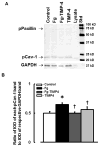Elevated level of fibrinogen increases caveolae formation; role of matrix metalloproteinase-9
- PMID: 24307281
- PMCID: PMC4020992
- DOI: 10.1007/s12013-013-9797-z
Elevated level of fibrinogen increases caveolae formation; role of matrix metalloproteinase-9
Abstract
The role of the inflammatory agent fibrinogen (Fg) in increased pial venular permeability has been shown previously. It was suggested that an activation of matrix metalloproteinase-9 (MMP-9) is involved in Fg-induced enhanced transcytosis through endothelial cells (ECs). However, direct link between Fg, caveolae formation, and MMP-9 activity has never been shown. We hypothesized that at an elevated level, Fg enhances formation of functional caveolae through activation of MMP-9. Male wild-type (WT, C57BL/6J) or MMP-9 gene knockout (MMP9-/-) mice were infused with Fg (4 mg/ml, final blood concentration) or equal volume of phosphate buffered saline (PBS). After 2 h, mice were sacrificed and brains were collected for immunohistochemical analyses. Mouse brain ECs were treated with 4 mg/ml of Fg or PBS in the presence or absence of MMP-9 activity inhibitor, tissue inhibitor of metalloproteinases-4 (TIMP-4, 12 ng/ml). Formation of functional caveolae was assessed by confocal microscopy. Fg-induced increased formation of caveolae, which was defined by an increased co-localization of caveolin-1 (Cav-1) and plasmalemmal vesicle-associated protein-1 and was associated with an increased phosphorylation of Cav-1, was ameliorated in the presence of TIMP-4. These results suggest that at high levels, Fg enhances formation of functional caveolae that may involve Cav-1 signaling and MMP-9 activation.
Figures














Similar articles
-
Fibrinogen-induced increased pial venular permeability in mice.J Cereb Blood Flow Metab. 2012 Jan;32(1):150-63. doi: 10.1038/jcbfm.2011.144. Epub 2011 Oct 12. J Cereb Blood Flow Metab. 2012. PMID: 21989482 Free PMC article.
-
Ablation of matrix metalloproteinase-9 gene decreases cerebrovascular permeability and fibrinogen deposition post traumatic brain injury in mice.Metab Brain Dis. 2015 Apr;30(2):411-26. doi: 10.1007/s11011-014-9550-3. Epub 2014 Apr 29. Metab Brain Dis. 2015. PMID: 24771110 Free PMC article.
-
Sphingolipids affect fibrinogen-induced caveolar transcytosis and cerebrovascular permeability.Am J Physiol Cell Physiol. 2014 Jul 15;307(2):C169-79. doi: 10.1152/ajpcell.00305.2013. Epub 2014 May 14. Am J Physiol Cell Physiol. 2014. PMID: 24829496 Free PMC article.
-
Cerebrovascular disorders caused by hyperfibrinogenaemia.J Physiol. 2016 Oct 15;594(20):5941-5957. doi: 10.1113/JP272558. Epub 2016 Jun 16. J Physiol. 2016. PMID: 27121987 Free PMC article.
-
Fibrinogen, Fibrinogen-like 1 and Fibrinogen-like 2 Proteins, and Their Effects.Biomedicines. 2022 Jul 15;10(7):1712. doi: 10.3390/biomedicines10071712. Biomedicines. 2022. PMID: 35885017 Free PMC article. Review.
Cited by
-
Regulation and involvement of matrix metalloproteinases in vascular diseases.Front Biosci (Landmark Ed). 2016 Jan 1;21(1):89-118. doi: 10.2741/4378. Front Biosci (Landmark Ed). 2016. PMID: 26709763 Free PMC article. Review.
-
A Role for the Cavin-3/Matrix Metalloproteinase-9 Signaling Axis in the Regulation of PMA-Activated Human HT1080 Fibrosarcoma Cell Neoplastic Phenotype.Cancer Growth Metastasis. 2014 Dec 8;7:43-51. doi: 10.4137/CGM.S18581. eCollection 2014. Cancer Growth Metastasis. 2014. PMID: 25520561 Free PMC article.
-
Effects of fibrinogen synthesis inhibition on vascular cognitive impairment during traumatic brain injury in mice.Brain Res. 2021 Jan 15;1751:147208. doi: 10.1016/j.brainres.2020.147208. Epub 2020 Nov 26. Brain Res. 2021. PMID: 33248061 Free PMC article.
-
Fibrinogen-cellular prion protein complex formation on astrocytes.J Neurophysiol. 2020 Aug 1;124(2):536-543. doi: 10.1152/jn.00224.2020. Epub 2020 Jul 22. J Neurophysiol. 2020. PMID: 32697670 Free PMC article.
-
The Role of Nuclear Factor-Kappa B in Fibrinogen-Induced Inflammatory Responses in Cultured Primary Neurons.Biomolecules. 2022 Nov 23;12(12):1741. doi: 10.3390/biom12121741. Biomolecules. 2022. PMID: 36551169 Free PMC article.
References
-
- Mehta D, Malik AB. Signaling mechanisms regulating endothelial permeability. Physiological Reviews. 2006;86:279–367. - PubMed
-
- Simionescu M, Popov D, Sima A. Endothelial transcytosis in health and disease. Cell and Tissue Research. 2009;335:27–40. - PubMed
-
- Komarova Y, Malik AB. Regulation of endothelial permeability via paracellular and transcellular transport pathways. Annual Review of Physiology. 2010;72:463–493. - PubMed
Publication types
MeSH terms
Substances
Grants and funding
LinkOut - more resources
Full Text Sources
Other Literature Sources
Research Materials
Miscellaneous

